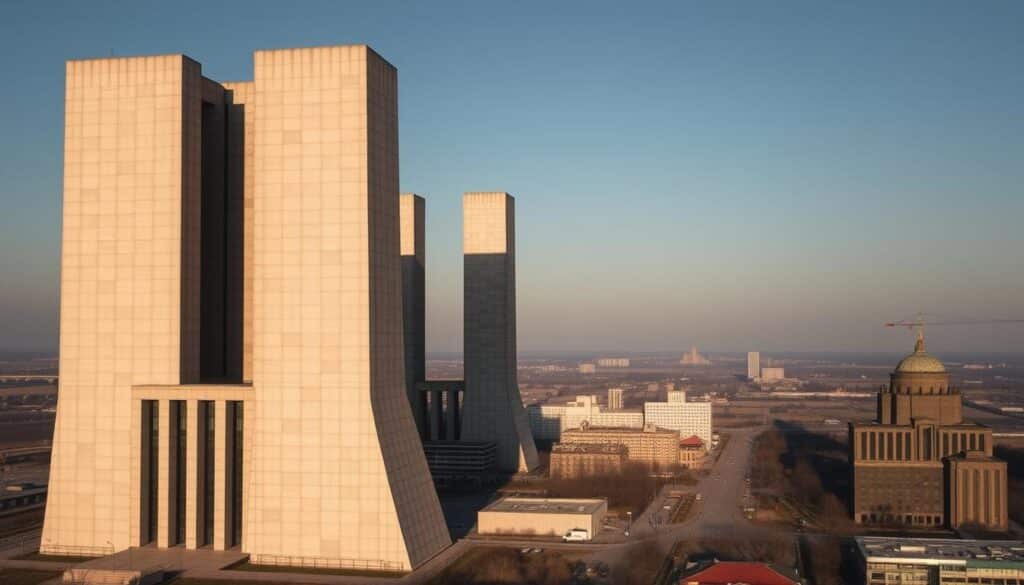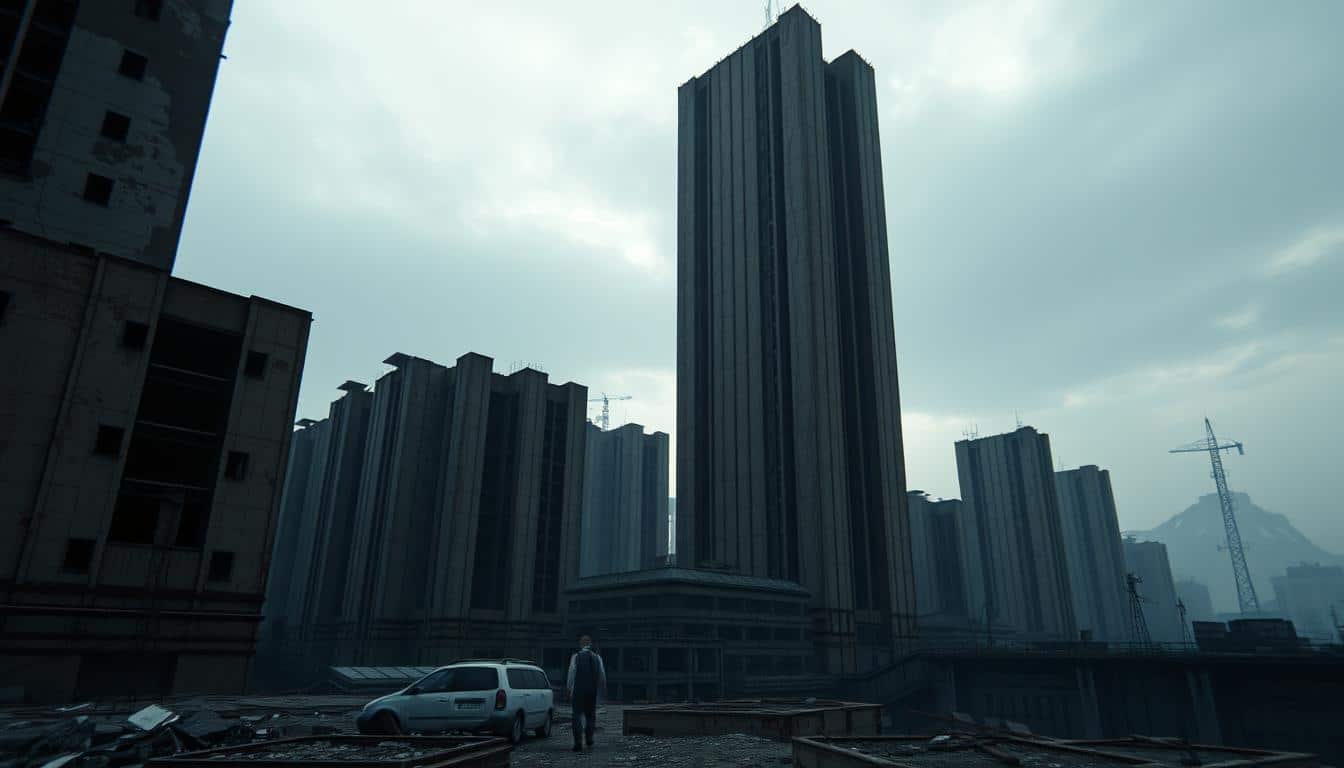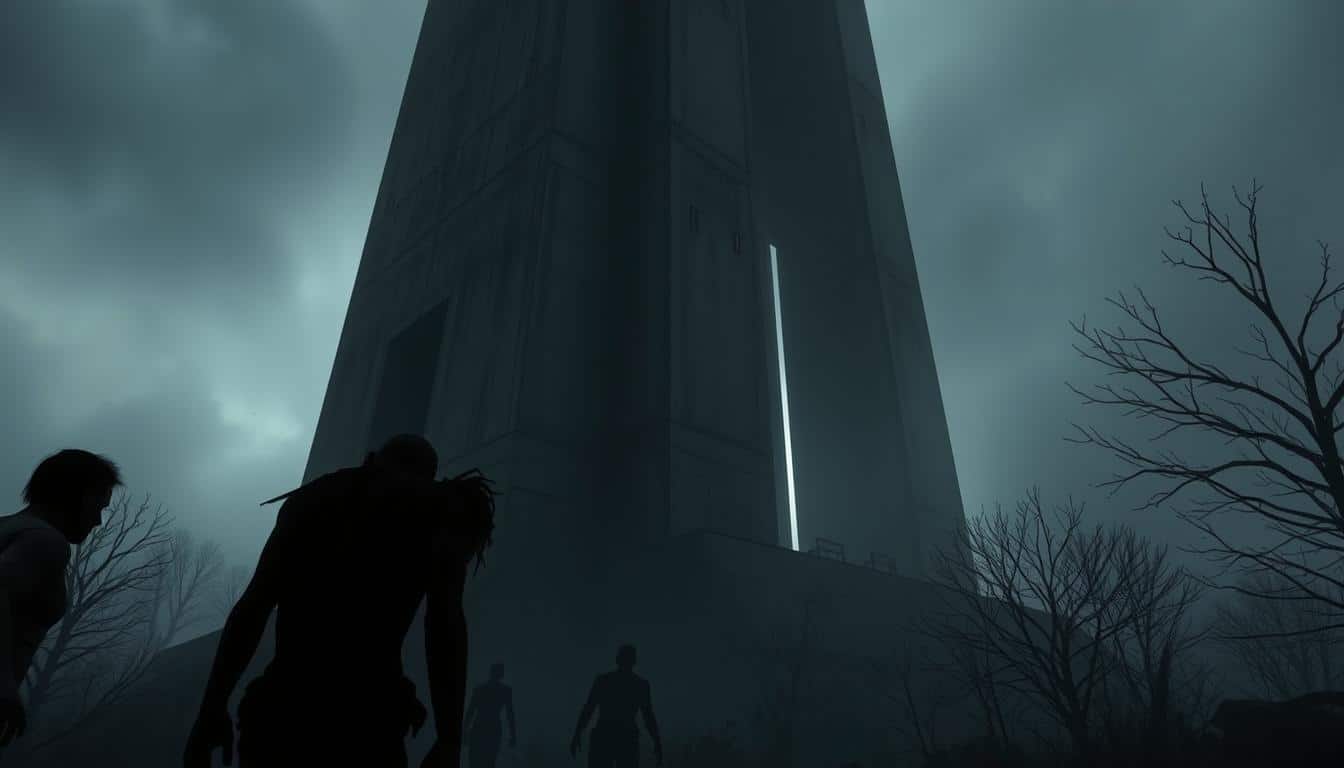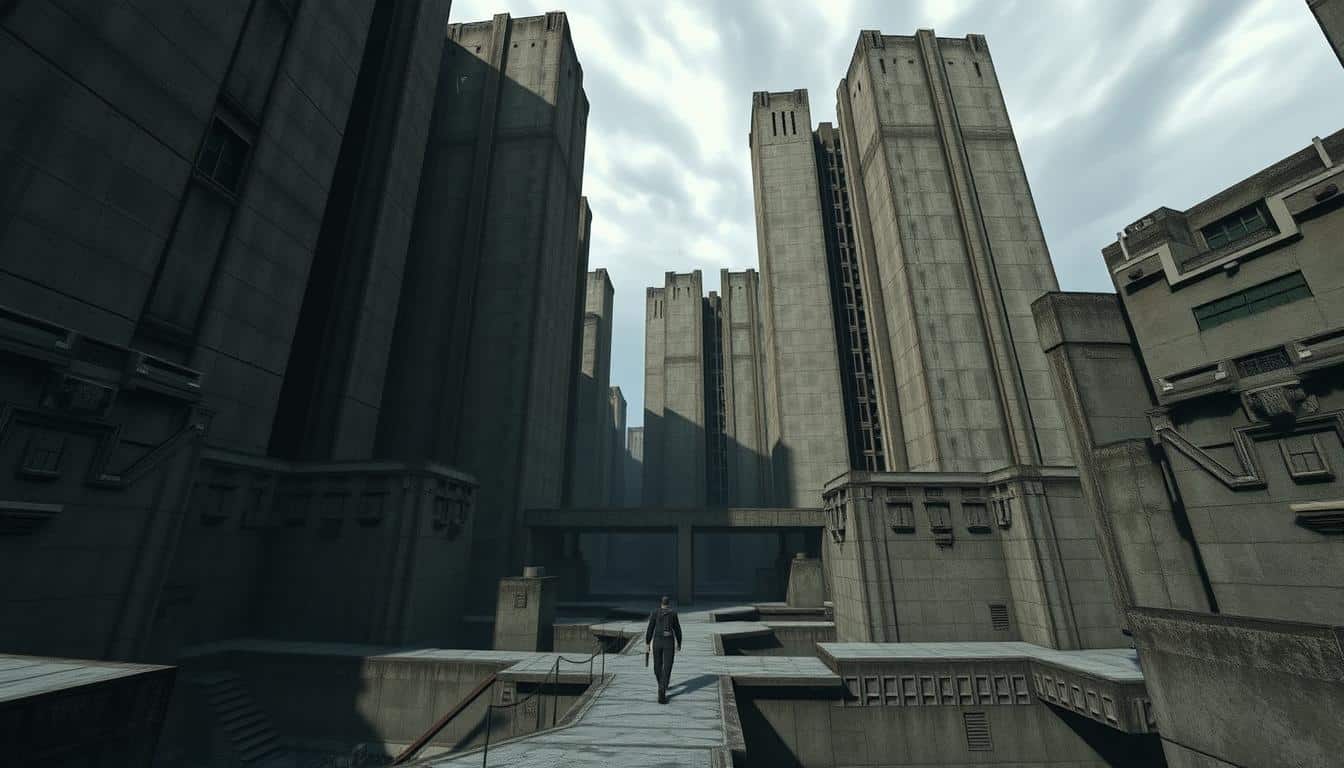Mixing Soviet Brutalism with video game design makes an intriguing scene. In it, buildings and structures guide the player’s journey. This piece digs into how the stark, straightforward look of Soviet Brutalism gets a new life in digital spaces. It doesn’t just change the look but also the play and story.
We’re looking at what makes this style stand out. And how it’s making a comeback in today’s games. Soviet Brutalism helps make game worlds more engaging. It pulls players into deep, meaningful adventures.
The Origins of Soviet Brutalism
Soviet Brutalism started in the late 1940s as a reaction to World War II’s destruction. It was key to rebuilding Europe’s cities and infrastructure. Architects chose simple materials like concrete to mirror the tough times.
The name “Brutalism” comes from “béton brut,” French for raw concrete. This name captures the stark style of Soviet buildings from that time. These buildings were more than concrete structures; they symbolized practicality and societal goals after the war. The focus was on being practical and efficient, which shaped Soviet architecture.

Defining Characteristics of Brutalist Architecture
Brutalist architecture has a special look, known for its simple, direct style. At its heart, it focuses on using raw materials that grab your attention. Concrete plays a big role in shaping these buildings. It’s not just about looks, but also about showing off their practical side. These structures stand out with their tough, bare designs that speak to strength and lasting power.
Brutalist buildings are straightforward, without fancy extras. Their bold presence makes people stop and think. When you see these huge structures against the backdrop of their environment, they’re truly impressive. This style goes beyond just buildings; it’s about showing toughness and practicality through architecture. It tells us about the values of the time it came from.
The Impact of Soviet Brutalism on Modern Design
Soviet Brutalism has greatly influenced modern design. It goes beyond architecture, affecting urban planning and interior design. This style’s ideas are seen in today’s city layouts and inside spaces.
Designers now value structure and material honesty, just like Brutalism does. Brutalism’s love for simplicity and the unrefined matches today’s eco-friendly and minimalist trends.
Some find Brutalism too stark or unwelcoming. Yet, it keeps inspiring new architectural work. Its impact shapes how designers view space and purpose, changing modern design’s direction.
Key Influential Figures in Brutalist Architecture
Leaders in Brutalist architecture really shaped its path. Le Corbusier, a top architect, saw buildings as “machines for living.” His ideas set the stage for many Brutalist buildings. They inspired architects to blend function with modernist views.
Alison and Peter Smithson also made big contributions. They pushed for designs that mattered to society and were practical. The Smithsons focused on new shapes and materials. They wanted to make spaces that reflected the challenges of modern life.
These architects have made a lasting impact on how buildings are made. Brutalist architecture continues to be admired because of them. Their insights sparked discussions on the role and effect of public spaces. This cements their place in the history of architecture.
The Role of Materials in Soviet Brutalism
Soviet Brutalism’s construction depended a lot on certain building stuff that gave it a special look. Concrete was super important for this style of building. It was mostly left rough and untouched, showing off the era’s strength and lasting nature. This choice of material matched the ideas of strength from that time.
Industrial Elements like metal and glass also played a big part in Soviet Brutalism’s look. These materials added a mix of use and art to the buildings. The use of big glass panels let in lots of light, making a nice contrast with the solid concrete.
This mix didn’t just look good but had practical uses too. The focus was on making buildings that were both helpful and looked amazing. The Building Materials used tell us a lot about what society hoped to achieve back then. They present an architectural story that is still interesting to us today.
Exploring Soviet Brutalism Elements Shaping Virtual Worlds
Using Soviet Brutalism in virtual worlds changes the way players interact with games. It brings a unique look and feel to game settings. This new approach makes games more immersive and thought-provoking.
Game designers use Brutalist styles to create deep connections with players. They also make players think about important social issues. This makes game worlds more meaningful and complex.
How Virtual Environments Recontextualize These Elements
Adding Brutalist features to games opens up new creative possibilities. The use of cold, industrial materials sets the mood for these digital places. It helps to build a distinct game environment.
This method helps make game worlds more engaging and emotionally rich. It also makes players think about city life and social structures. Plus, it stresses the importance of simple, functional design.
Through these methods, games become a new way to look at architecture. They allow players to experience and think about spaces in a whole new light. This enriches both the design of games and the experiences of players.
Iconic Examples of Soviet Brutalism in Video Games
Video games that use Soviet brutalism give players special experiences. “Control” and “NaissanceE” show how this style adds to the story and fun. These games use large, simple buildings to make their worlds feel real and interesting.
Case Study: Control by Remedy Entertainment
“Control” features the Oldest House, a place beyond normal buildings. It changes shape, showing the game’s deep story. The way the character moves through the building shows Soviet brutalism’s effect. It makes players feel both trapped and eager to explore.
Case Study: NaissanceE’s Unique Architectural Choices
“NaissanceE” also uses brutalism to set the mood. Its big, bare buildings create a feel of wonder and mystery. As players move around, they see how architecture shapes the game. This shows the power of design in making games fun.
The Aesthetic Experience of Virtual Brutalism
Virtual brutalism shows captivating landscapes that players explore. These areas, with their stark designs and simple materials, make the game feel more real. They make players think deeply about the stories these buildings tell.
In games with this style, the architecture is more than just a backdrop. It helps tell the story, affecting how players feel and interact. This mix of space and story draws players in, letting them connect with the world around them.
Striking visuals boost the feel of being in the game. Players see massive buildings and wide-open spaces. They start to think about their role and the bigger picture behind the game’s design. This shows how important visuals are, not just for playing the game, but for the full experience.
The Fusion of Architecture and Gameplay Dynamics
The link between Brutalist architecture and gameplay changes the way players interact with games. Structural features in these buildings affect the game’s mechanics. Large concrete areas don’t just offer strategies. They also shape the game’s emotional feel, making it deeper for the player.
Game designers often use architecture to improve their games. Adding big concrete buildings makes players feel small but curious. It urges them to look around. This feeling of being tiny can stir up emotions. It makes the game worlds seem more real and inviting.
Moreover, the daunting feel of Brutalist designs pushes players to explore their environment more. They have to move through and interact with these well-planned spaces. This connection deepens the gamer’s link to the story, enhancing their enjoyment.
The Cultural Narrative of Liminal Spaces in Gaming
Liminal Spaces in gaming offer a special cultural story. They represent transition periods that make players feel unsure. The use of Brutalism’s strong look helps tell this story better. This kind of architecture makes environments that are both new and known.
Here, players really dive into their environment. This Experience goes beyond normal game playing. They move through places that make them see things differently, often thinking about being alone and life’s big questions. This mix of design and feelings highlights Liminal Spaces’ deep messages about life.
Conclusion
Soviet Brutalism has a big influence in virtual worlds, giving them a unique look that players find appealing. The style’s rough features not only bring back memories but also make game stories more emotional.
This architectural style’s mark can be seen in many video games. It makes games more engaging and improves how stories are told. Looking ahead, Brutalism’s ideas will keep shaping the making of new, virtual worlds.
By mixing Brutalism in games, creators make stunning and meaningful experiences. This shows how architecture from the past can add to today’s digital worlds. It opens up new ways to mix old architectural styles with current games.



